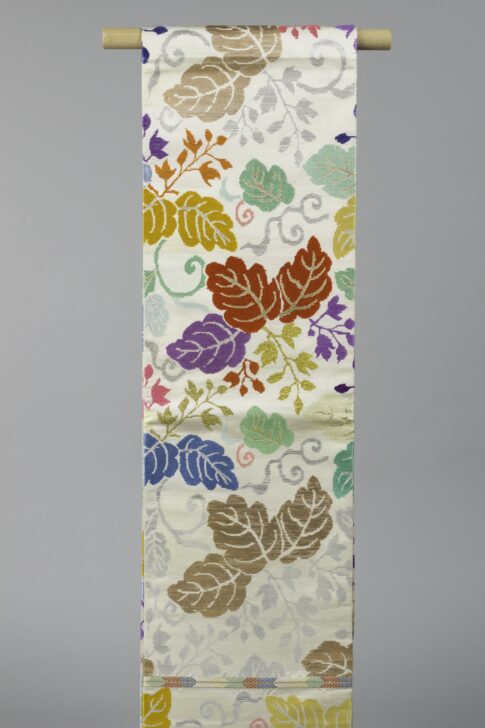Obi
Japanese

Description
Obi
Japan
Shōwa era (1926–89)
Mid- to late 20th century
Silk brocade
Gift of Mrs. Kazuko Miyake, 2016/2.24
This maru obi (or “one-piece obi”) was produced in the Nishijin area
of Kyoto city, which has dominated the production of high-quality
woven textiles since the fifteenth century. The Nishijin production
process specialized in five main areas—designing and creating
patterns, producing silk threads, producing tools (including weaving
machines), weaving, and final sewing—each executed in a different
workshop. Nishiki is a type of vibrant silk brocade with vivid and
luxurious images created from various colored and metallic (mainly
gold and silver) threads. Maru obi are the most formal type of obi.
They have elaborate patterned brocade or tapestry on both sides, and
they are typically richly decorated with gold thread. The maru-style
obi was most popular during the Meiji (1868–1912) and Taisho (1912–25)
eras. However, due to its excessive cost and uncomfortable weight it is
rarely worn today.
(Japanese Gallery Rotation, Summer 2025)
Subject Matter:
This is a Nishijin, Nishiki, and Maru obi in zentsuu gara.
Maru obi are the most formal type of obi, having elaborate patterned brocade or tapestry on both sides, typically decorated with rich gold thread. The classic maru obi measures 13inc (33cm) wide. It was most popular during the Meiji (1867-1912) and Taisho period (1912-1925). However, the maru obi is rarely worn today due to its excessive cost and uncomfortable weight.
Nishijin-ori textiles were developed in the Nishijin area of Kyoto city and has dominated the production of high-quality woven textiles since the fifteenth century. The production of Nishijin textiles is very complex and is specialized in five main areas—designing and creating patterns, producing silk threads, producing tools (including weaving machines), weaving, and final sewing—each executed in a different workshop.
Nishiki is a type of vibrant silk brocade with vivid and luxurious images using various colorful and metallic (mainly gold and silver). Nishiki brocade is mainly produced in the Nishijin area of Kyoto.
Gara refers to the orientation, arrangement, and surface area of the patterns and pertains to a specific trend and obi tying style.
In the Zentsuu gara type, the obi is entirely covered with designs, patterns, and motifs. The versatility of this patterning allows for a variety of obi tying styles.
Physical Description:
white maru (double-sided) obi with interwoven karakusa and paulownia motifs in various colors and metallic threads.
Usage Rights:
If you are interested in using an image for a publication, please visit https://umma.umich.edu/request-image/ for more information and to fill out the online Image Rights and Reproductions Request Form.